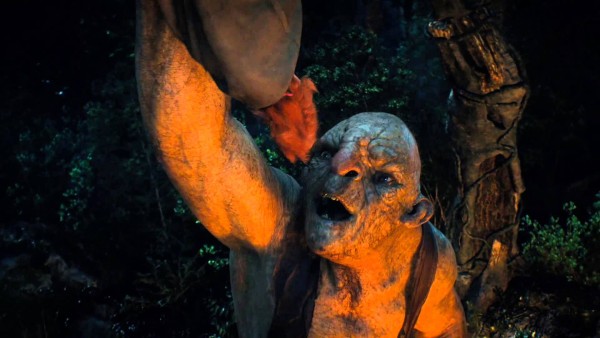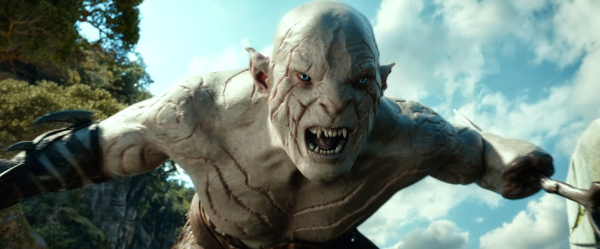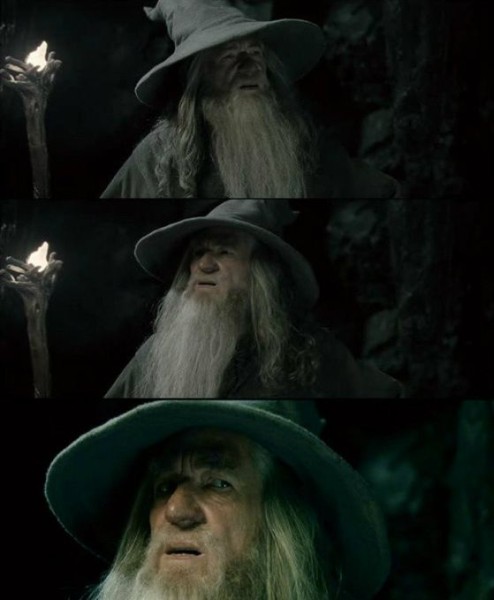When I originally set out to write this article a few months back I had just finished rereading The Hobbit and watching the first two films in eager anticipation of seeing The Battle of the Five Armies (#OneLastTime). It had been awhile since I had read the book, and I was a little rusty in terms of Hobbit trivia, so before the final film I wanted to really dive in and see how close the films were to the novel. Unfortunately rereading the book immediately prior to watching the nearly ten hours of film made me realize that there were more changes than I would’ve expected.
Now before I really dive in I want to say that I understand that there will always be differences between books and their prospective films. Ultimately books and films are different art forms and require different approaches. Sometimes the changes a film makes to the source material make sense, such as when they decided to make Ender the same age the entire movie instead of having the film take place over ten years (presumably sparing us from the horrible CGI creature they used in the Twilight Saga to show Rene… Re… Kristen Stewart’s daughter rapidly aging). Other times, like Rob Lowe’s Salem’s Lot, the film is so far off that they changed key aspects of the story for no reason at all. If the subjective spectrum is set with Salem’s Lot on one end (the bad end), and Ender’s Game on the other, The Battle of the Five Armies falls squarely in the middle.
Obviously there are going to be some major spoilers here, but I will save the discussion for The Battle of the Five Armies until later in the article and will preface it with a SPOILER warning.
In a vacuum, these movies are great – they are a fun and adventurous story with impeccable casting – but there are several differences ranging from “wait what?” to “I don’t even know what’s happening anymore” scattered throughout the films. Initially the changes were relatively innocent and had little impact on the overall story, but towards the end it felt like Jackson might have gotten so caught up in the new narrative that he got lost along the way. The Unexpected Journey probably was the most true to it’s prospective chapters. Most of the changes I noticed could be rationalized pretty easily, such as when the Dwarves first arrive in Rivendell. In the books they are greeted as guests, but in the film they are immediately surrounded by a hunting party and have a tense standoff with the Elves. Ultimately this move makes at least a modicum of sense as it shows the Dwarves and Elves aren’t particularly fond of each other, which fits within the lore.
There’s also a scene where the Dwarves and Bilbo stumble upon a trio of Trolls (Bert, Bill and Tom) that decide a baker’s dozen of Dwarves sounds much more appetizing than the mutton they have been eating. In the film, the trolls are distracted by Bilbo until Gandalf (who is just hanging out on some rocks while the Dwarves are about to be cooked alive) shatters a rock and the sun shines through turning the trolls into stone. In the book Gandalf mimics the voices of the trolls to keep them arguing with each other until the sun rises above the horizon (trolls aren’t the sharpest tool in the Hobbit hole). Neither of these changes really impact the overall story, and can be attributed to the “necessity” of action in lieu of more creative solutions in blockbuster movies.

It’s important to note that the book focuses almost exclusively on Bilbo Baggins, as it is supposed to be a memoir of sorts. This means that all of the scenes with Gandalf and the Necromancer, the meeting of the White Council, Azog (the one-armed Goblin who in the book was killed prior to the quest to Erebor), Radagast the Brown, etc. were all added. Some of this was pulled directly from other sources such as The Silmarillion and The Quest of Erebor, which is found in Unfinished Tales of Númenor and Middle-Earth. Obviously there is a good deal of embellishment in these additions since the writers had to invent dialogue and actions for the characters involved, but at least there are technically a part of the “Legendarium.” That’s not to say that certain… liberties weren’t taken. Radagast, for instance, was vaguely mentioned in any of these sources, but had a much larger part in the films (He wasn’t a champion rabbit bobsledder, and didn’t ride eagles very often). Other changes: Thorin and Co weren’t chased into Rivendell by goblins and wargs; the Dwarves didn’t end up riding the knees of the stone-giants; didn’t lead a group of goblins after the Dwarves having been killed before The Hobbit began; the Dwarves weren’t chased into Beorn’s house by Beorn as a black bear, instead they were introduced two by two by Gandalf.
The second film, The Desolation of Smaug, began to make more significant changes to the source material and these changes snowballed into The Battle of the Five Armies. In Desolation, Fili, Thorin’s nephew, falls in love with the Wood elf, Tauriel. This creates a love triangle between Fili, Tauriel, and Legolas, who also has a thing for Tauriel. Here’s the thing, not only did this love triangle not exist in any context in the book, Tauriel didn’t exist either. She was created specifically for the love triangle story arc. Legolas was also not technically in The Hobbit, but he was the son of Thranduil, the Elvenking, so it’s plausible that he would’ve been around when the Dwarves were imprisoned.
This love triangle eventually led to Fili getting shot with a poison arrow and Tauriel traveling to Lake-town with Legolas just in time to save Fili and defend the town from an attack by Azog the Defiler and his Goblin pack. Eventually this prevents Fili, his brother Kili, and a couple other Dwarves from going to Erebor with the rest of Thorin’s company, none of which actually happened in the book. See how the one change led to more and more changes?
Also, the fight scene between the Dwarves and Smaug was film only. I assume this was to show that the Dwarves tried to defeat the dragon themselves and give them more of a claim to their treasure than the people of Lake-town. In the book, Bilbo does have a run in with Smaug, but when he escapes back into the tunnels Smaug decides to destroy Lake-town leaving the Dwarves to wander the halls of Erebor. I get the reason they added the scene as it was a good climactic battle between the company you’ve been following for two movies and the new villain, but it was a difference. Oh, and the Master of Lake-town didn’t imprison Bard; Bard didn’t help the Dwarves out of their barrels; Goblins didn’t attack them on their way down the river; Bilbo didn’t try to protect Thorin from Azog (because that there wasn’t a fight during this scene); and the Elves didn’t save the Dwarves from the giant spiders.
This leads us to the third and final film, SPOILERs abound.
All of the changes led to a third movie that was pretty far off course, as far as the source material is concerned. So this film starts off with Smaug laying the smackdown on Lake-town. Bard escapes prison, and with the help of his son fires a giant black arrow off his son’s shoulder that brings down Smaug. In the book, Bard did kill the dragon with a black arrow (with a normal bow), but his son was not involved and a prison break wasn’t required (and the Master escaped the town instead of being crushed to death trying to escape).
That being said, what really lost me was the actual Battle of the Five Armies. As far as climactic battles are concerned this one was a lot of fun, but it did veer wildly off course as far as the book is concerned. There were indeed five armies involved in the battle (dwarves, men, goblins, elves, and eagles), and it was dwarves, men, elves and eagle versus the goblins. However, Azog didn’t lead the goblin army because he was dead. Instead, his son Bolg was in charge. The whole revenge story aspect between Thorin (for the death of his kin) and Azog (for the death of his arm) was pretty unnecessary and only served to force the narrative further off course.

The biggest change in the final film, or at least the one that bothered me the most, was the SPOILER death of Fili, Kili, and Thorin. My gripe isn’t so much that they died – because they died in the book as well – my problem is with the manner in which they died. In the film, Fili is killed by Azog to urge Thorin into fighting him. Kili is killed by Bolg as he fights alongside Tauriel, who loved Fili, avenging Fili’s death. Thorin then seemingly kills Azog, but in a classic movie cliché, Azog not only isn’t dead yet, but mortally wounds Thorin before Thorin actually kills him. All of that is fine, I guess, but I was kind of looking forward to seeing how this happened from the books perspective.
In the book, Thorin is mortally wounded after being overrun by goblins as he commands the armies of dwarves, men, and elves. His nephews, Kili and Fili die trying to shield Thorin’s body from further attack by the goblin forces. Thorin lives long enough to ask Bilbo his forgiveness and is buried deep beneath the mountain. While this might not be as climactic as the final battle in the movies, it certainly carries more weight, to me at least. Other notable changes: Radagast didn’t bring the eagles, nor did he ride them into battle; Legolas didn’t give Thorin his sword back during the battle – it was placed on Thorin’s tomb by the Elvenking; the unibrowed, Wormtongue wannabe didn’t crossdress to hide with the women, nor did he hail Bard as the new king of Dale because he wasn’t in the book at all; and, most importantly, Bilbo never did find his silver-spoons after they were auctioned off to the Sacksville-Bagginses.
While the overall tone of this article might sound negative, I actually did enjoy these films. They were entertaining, and even though they got progressively further and further away from the book, it was still nice to see Tolkien’s universe again. If you like adventure films, you should like the Hobbit trilogy, but if you are a strict bibliophile you might have a hard time. The sweet spot is right in the middle, where you understand the changes and are somewhat bothered by them, but ultimately are just happy to have someone take the time, effort, and capital to bring one of your favorite worlds to life one last time.

